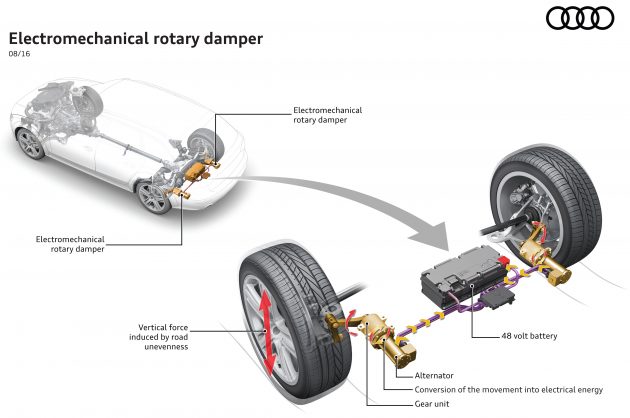Think energy regeneration, and usually innovations in the powertrain aspects come to mind. With a prototype named “eROT”, Audi has applied the same principles to the chassis, or more specifically the dampers of a vehicle, in order to recuperate energy transferred through the vehicle’s chassis as it encounters undulations and imperfections along the road surface.
“Every pothole, every bump, every curve induces kinetic energy in the car. Today’s dampers absorb this energy, which is lost in the form of heat,” said Dr. Ing. Stefan Knirsch, board member for technical development at Audi AG.
“With the new electromechanical damper system in the 48-volt electrical system, we put this energy to use. It also presents us and our customers with entirely new possibilities for adjusting the suspension,” he adds.
The rotary motion allows the electric motors to be mounted horizontally, thus saving space compared to conventional upright telescopic dampers, which allows for better use of space in that area of the vehicle.
Audi says this configuration eliminates the mutual dependence of the rebound and compression strokes that limits conventional hydraulic dampers, and opens up possibilities of damper characteristics which are freely definable by software.
A lever arm absorbs the motion of the wheel carrier it is mounted to, and uses the energy from both compression and rebound movements of the suspension drive an electric motor via a series of gears, which converts the forces from kinetic energy to electricity.
Audi has found in testing that the recuperation output averages from 100 to 150 watts on Germans roads; from 3 watts on a smooth, freshly paved freeway to 613 watts on a rough, secondary road. This translates into CO2 emissions savings of up to 3g per km, according to Audi.
The new eROT technology is based on a 48-volt electrical architecture, configured with a lithium-ion battery with an energy capacity of 0.5 kWh and a peak output of 13kW. A DC converter connects the 48-volt electrical subsystem to the 12-volt primary electrical system, which includes an enhanced output generator.
With plans to increase the implementation of the 48-volt electrical architecture in future models, the inclusion of eROT technology in future production Audis is plausible, says the company, as it says initial test results for the technology are promising.
A subsequent version is planned for next year, when the 48V electrical system will serve a primary role in a new Audi model – a variant of the A4 Avant, judging from the diagram – with a high-performance, mild hybrid drive layout.
Looking to sell your car? Sell it with Carro.























With the amount of potholes and extreme undulations along our roads in Malaysia, this could means future Audis can be self-powered to be driven in Malaysia. If Germans can do 613 watts, we could easily do 6 Mwatts.
Our contractors are simply geniuses! They know this is coming. I salute you contractors 3 kali!
**esaelp msacras eht dear**
Much more interested in the system to improve comfort… some companies have developed similar systems that use the electric motors to adjust the wheel position. That way it can swallow bumps in the road. There is a rather impressive demonstration of a HUMMER H1 going over a very, very rough road, without and impact on the interior.
Should be more energy harvested on malaysia road
if in malaysia..one day travel can produce 1month TNB bill..
If on Malaysian roads, Fuyoh 1000 watts! No need hybrid no need petrol, just bumpgedebop gedebop all the way Hahaha!
P1 Engineer: Abende ni? Pedulilah. Minum kopi dulu.
Betul… Peduli apa jerman overlord buat ni? Kita syok sendiri lebih baik
PT reader : Abende ni? Pedulilah. Sampah comment
our roads will melt the system from generating too much excess power.
someone should design the same for my mousewheel. i will generate enough power to run my cubicle
What’s a mousewheel?
Malaysia road ?..u guys think our road is the worst in the asia?..hahaha..
clearly you guys never been to Thailand/Indonesia/vietnam/ laos/India..etc. South America country?
Good…. Maintenance will make SC wide smile, no others can do it. Customer will cry like hell. What a typical eu cars…..
Yeah, you’d prefer horse carts…
who needs solar power when we have potholes :)
Lies!! malaysia don’t have pot holes…..
Malaysia have only big pot holes….
being audi, it will breakdown soon and costly